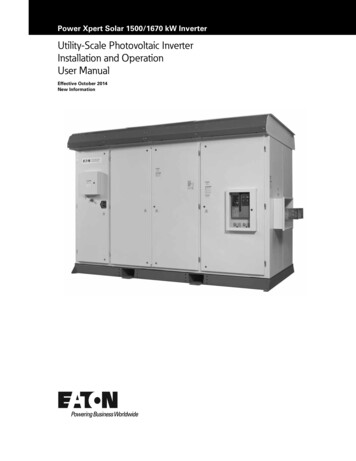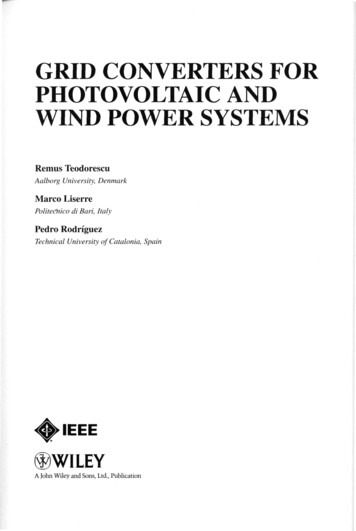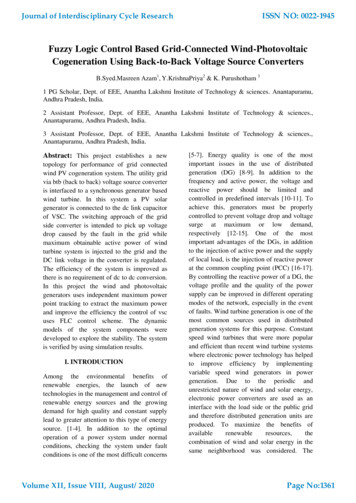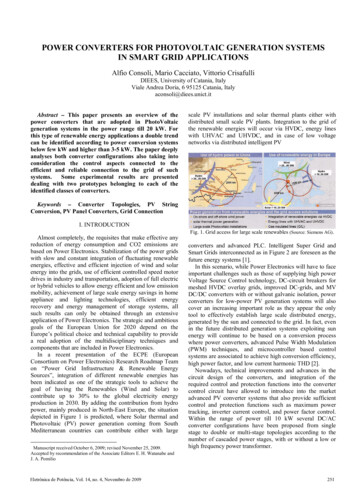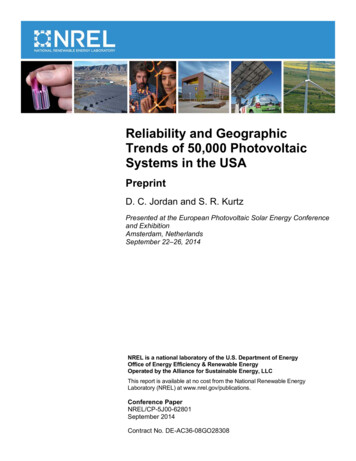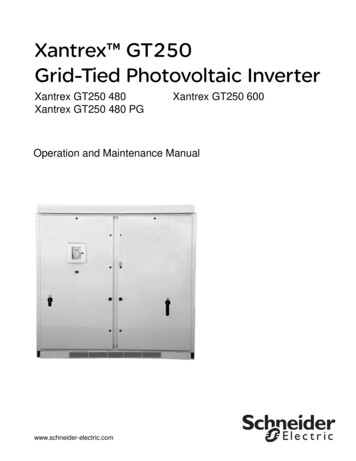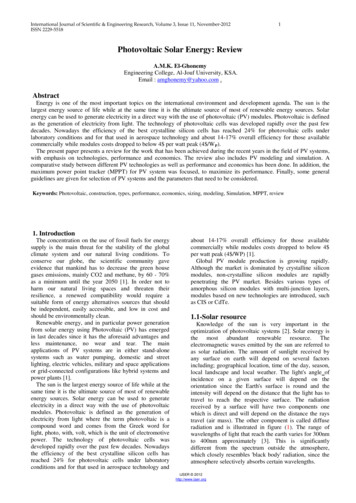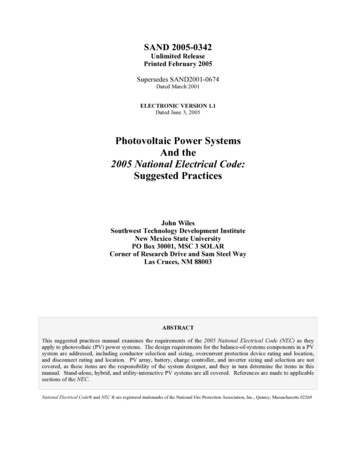
Transcription
SAND 2005-0342Unlimited ReleasePrinted February 2005Supersedes SAND2001-0674Dated March 2001ELECTRONIC VERSION 1.1Dated June 3, 2005Photovoltaic Power SystemsAnd the2005 National Electrical Code:Suggested PracticesJohn WilesSouthwest Technology Development InstituteNew Mexico State UniversityPO Box 30001, MSC 3 SOLARCorner of Research Drive and Sam Steel WayLas Cruces, NM 88003ABSTRACTThis suggested practices manual examines the requirements of the 2005 National Electrical Code (NEC) as theyapply to photovoltaic (PV) power systems. The design requirements for the balance-of-systems components in a PVsystem are addressed, including conductor selection and sizing, overcurrent protection device rating and location,and disconnect rating and location. PV array, battery, charge controller, and inverter sizing and selection are notcovered, as these items are the responsibility of the system designer, and they in turn determine the items in thismanual. Stand-alone, hybrid, and utility-interactive PV systems are all covered. References are made to applicablesections of the NEC.National Electrical Code and NEC are registered trademarks of the National Fire Protection Association, Inc., Quincy, Massachusetts 02269
PHOTOVOLTAIC POWER SYSTEMS and the NATIONAL ELECTRICAL CODEACKNOWLEDGMENTSNumerous people throughout the photovoltaic industry and the electrical inspector community reviewed the earliereditions of this manual and provided comments that are incorporated in this edition. The author sends heartfeltthanks to all who have supported the efforts to improve and expand the document. With inputs from all involved,each succeeding edition is progressively more detailed and complete. Ward Bower at Sandia National Laboratoriesdeserves special thanks for his dedicated and continuing support and review of this document. Ronald Donaghe,Southwest Technology Development Institute, performed document editing and layout.TECHNICAL COMMENTS TO:John C. WilesSouthwest Technology Development InstituteNew Mexico State UniversityP.O. Box 30001/MSC 3 SOLARCorner of Research Drive and Sam Steel WayLas Cruces, New Mexico 88003-0001Phone: 505-646-6105 FAX 505-646-3841 e-mail: jwiles@nmsu.eduCopies may be downloaded from the PV and Codes links on the SWTDI/NMSU web site athttp://www.nmsu.edu/ tdiPURPOSEThis document is intended to contribute to the widespread installation of safe, reliable PV systems that meet therequirements of the National Electrical Code.DISCLAIMERThis guide provides information on how the 2005 National Electrical Code (NEC) applies to photovoltaic systems.The guide is not intended to supplant or replace the NEC; it paraphrases the NEC where it pertains to photovoltaicsystems and should be used with the full text of the NEC. Users of this guide should be thoroughly familiar with theNEC and know the engineering principles and hazards associated with electrical and photovoltaic power systems.The information in this guide is the best available at the time of publication and is believed to be technicallyaccurate. Application of this information and results obtained are the responsibility of the user.In most locations, all electrical wiring including photovoltaic power systems must be accomplished by, or under thesupervision of, a licensed electrician and then inspected by a designated local authority. Some municipalities haveadditional codes that supplement or replace the NEC. The local inspector has the final say on what is acceptable. Insome areas, compliance with the NEC is not required.NATIONAL FIRE PROTECTION ASSOCIATION (NFPA) STATEMENTThe National Electrical Code including the 2005 National Electrical Code is published and updated every threeyears by the National Fire Protection Association (NFPA), Batterymarch Park, Quincy, Massachusetts 02269. TheNational Electrical Code and the term NEC are registered trademarks of the National Fire Protection Associationand may not be used without their permission. Copies of the current edition of the National Electrical Code and theNational Electrical Code Handbook are available from the NFPA at the above address, most electrical supplydistributors, and many bookstores.ii
PHOTOVOLTAIC POWER SYSTEMS and the NATIONAL ELECTRICAL CODETable of contentsSUGGESTED PRACTICES. 1Introduction . 1Methods of Achieving Objectives . 3Scope and Purpose of the National Electrical Code . 4This Guide. 5Longevity, Materials, and Safety. 5Testing and Approval. 6Photovoltaic Modules . 7Module Marking . 7Wiring. 9Module Interconnections . 9Tracking Modules . 10Terminals. 11Transition Wiring. 13Module Connectors . 15Module Connection Access . 15Splices . 15Conductor Color Codes. 18PV Array Ground-Fault Protection. 18PV Array Installation and service. 19Grounding . 20Definitions . 20Grounding—System. 20Size of DC Grounding Electrode Conductor . 21Point of Connection . 21Unusual Grounding Situations . 23Charge Controllers—System Grounding. 24Ungrounded Systems . 25Equipment Grounding . 25Inverter AC Outputs. 26PV Inverters Create Separately Derived Systems. 26AC Grounding . 27DC Grounding . 27Backup Generators . 28iii
PHOTOVOLTAIC POWER SYSTEMS and the NATIONAL ELECTRICAL CODESuggested AC Grounding. 29Grounding Electrode . 29Conductor Ampacity. 31Stand-Alone Systems—Inverters. 33Overcurrent Protection. 33Ampere Rating . 34Branch Circuits . 37Amperes Interrupting Rating (AIR)—Short-Circuit Conditions . 38Fusing of PV Source Circuits . 39Current-Limiting Fuses—Stand-Alone Systems . 40Current-Limiting Fuses—Utility-interactive Systems . 41Fuse Servicing. 41Disconnecting Means. 41Photovoltaic Array Disconnects . 42PV Disconnect Location. 42Equipment Disconnects. 43Battery Disconnect . 44Charge Controller Disconnects. 46UNGrounded Systems. 47Multiple Power Sources . 47Panelboards, Enclosures, and Boxes . 47Batteries . 48Hydrogen Gas . 48Battery Rooms and Containers . 49Acid or Caustic Electrolyte. 49Electric Shock Potential . 50Battery and other large Cables. 50Generators . 50Charge Controllers. 52Inverters . 53Stand-Alone Distribution Systems . 53Interior DC Wiring and Receptacles . 56Smoke Detectors . 58Ground-Fault Circuit Interrupters . 58Interior Switches . 58Multiwire Branch Circuits. 59AC PV Modules . 61System Labels and Warnings . 62iv
PHOTOVOLTAIC POWER SYSTEMS and the NATIONAL ELECTRICAL CODEPhotovoltaic Power Source. 62Multiple Power Systems. 62Interactive System Point of Interconnection . 62Switch or Circuit Breaker. 62General . 63Inspections. 63Insurance . 63APPENDIX A: Sources of Equipment Meeting the Requirements ofThe National Electrical Code . A-1Conductors. A-1DC-Rated Fuses . A-2Enclosures and Junction Boxes. A-4HYDROCAPS . A-4APPENDIX B: PV Module Operating Characteristics Drive NEC Requirements . B-1Introduction. B-1Unspecified Details . B-2NEC Requirements Based on Module Performance . B-2Voltage. B-2Current . B-3Additional NEC Requirements . B-3Summary. B-4APPENDIX C: Utility-Interactive Systems . C-1Inverters. C-1PV Source-Circuit Conductors . C-3Overcurrent Devices. C-3Backfed Circuit Breakers, The National Electrical Code and UL Standards . C-3Utility-Interactive PV Systems. C-3Summary . C-5Disconnects. C-5Blocking Diodes. C-5Surge Suppression. C-6APPENDIX D: Cable and Device Ratings at High Voltages . D-1Equipment Ratings. D-1NEC Voltage Limitation. D-4Voltage Remedies . D-4APPENDIX E: Example Systems .E-1Cable Sizing and Overcurrent Protection .E-1Examples .E-3APPENDIX F:DC Currents on Single-Phase Stand-alone Inverters.F-1APPENDIX G: Grounding PV Modules . G-1v
PHOTOVOLTAIC POWER SYSTEMS and the NATIONAL ELECTRICAL CODEAPPENDIX H: PV Ground Fault Protection Devices andThe National Electrical Code, Section 690.5. H-1APPENDIX I: Selecting Overcurrent Devices and Conductors in PV Systems.I-1APPENDIX J: Module series fuse requirements.J-1PV Modules and the Series Overcurrent Device .J-1APPENDIX K: Flexible, Fine-Stranded Cables: Incompatibilities withSet-Screw Mechanical Terminals and Lugs . K-1Solutions . K-3APPENDIX L: Ungrounded PV Systems.L-1Index . 1Distribution List. 1vi
PHOTOVOLTAIC POWER SYSTEMS and the NATIONAL ELECTRICAL CODEList of FiguresFigure 1:Warning Label . 6Figure 2.Label on Typical PV Module. 8Figure 3.Strain Reliefs. 9Figure 4.Terminal Crimping Tools. 12Figure 5.Crimp Terminals/Lugs . 12Figure 6Mechanical Terminals . 13Figure 7.PV Combiner with Circuit Breakers. 14Figure 8.Common Splicing Devices. 16Figure 9.Module Interconnect Methods . 17Figure 10.Typical System: Possible Grounding Conductor Locations . 22Figure 11.Utility-Interactive Inverter with Internal DC Bonding Point, GFPD, and Connection Point forGrounding Electrode Conductor . 23Figure 12.External Ground-Fault Protection Device. 28Figure 13.Example Grounding Electrode System . 30Figure 14.Typical Array Conductor Overcurrent Protection (with Optional Subarray Disconnects). 35Figure 15.Listed Branch-Circuit Rated Breakers. 36Figure 17.Listed Supplementary (left) and Branch Circuit(right) Fuses. 37Figure 18.Unacceptable Automotive Fuses (left) and Unacceptable AC Fuses (right) . 38Figure 19.Small System Disconnects . 45Figure 20.Separate Battery Disconnects. 45Figure 21.Charge Controller Disconnects . 46Figure 22.Disconnects for Remotely Located Power Sources. 51Figure 23.Typical Charge Controller. 52Figure 24.12-Volt DC Load Center . 55Figure 25.12-Volt DC Combining Box and Load Center . 56Figure 26.NEMA Plug Configurations. 57Figure 27.Diagram of a Multiwire Branch Circuit . 61Figure C-1. 400 Amp Panel – Commercial PV Installation. C-2Figure D-1. Typical Bipolar System with Fault . D-3Figure E-1. Direct Connected System .E-4Figure E-2. Direct-Connected PV System with Current Booster .E-6Figure E-3. Stand-Alone Lighting System.E-8Figure E-4. Remote Cabin DC-Only System. E-10Figure E-5. Small Residential Stand-Alone System. E-12Figure E-6. Medium Sized Residential Hybrid System . E-15vii
PHOTOVOLTAIC POWER SYSTEMS and the NATIONAL ELECTRICAL CODEFigure E-7. Roof-Top Utility-interactive System . E-18Figure E-8. Center-Tapped PV System . E-21Figure E-9. Utility-Interactive Three-Inverter System . E-24Figure F-1. Inverter Current Waveform (dc side) .F-1Figure G-1. ILSCO GBL4-DBT Lug. G-2Figure G-2. Improper Module Grounding . G-4Figure H-1. Ground-Fault Current Paths . H-1Figure K-1. Examples of Mechanical Terminals . K-1Figure K-2. Destroyed Mechanical Terminal From PV System . K-2Figure K-3viiiTypical Compression Lug . K-3
PHOTOVOLTAIC POWER SYSTEMS and the NATIONAL ELECTRICAL CODEAPPLICABLE ARTICLESIn the2005 NATIONAL ELECTRICAL CODEAlthough most portions of the National Electrical Code apply to all electrical power systems,including photovoltaic power systems, those listed below are of particular 36338340352356366400408445480490690705720Ch 9, Table 8Annex CContentsIntroductionDefinitionsRequirements for Electrical InstallationsUse and Identification of Grounded ConductorsBranch CircuitsOvercurrent ProtectionGrounding and BondingWiring MethodsConductors for General WiringNonmetallic-Sheathed Cable: Types NM, NMC, and NMSPower and Control Tray Cable: Type TCService-Entrance Cable: Types SE and USEUnderground Feeder and Branch-Circuit Cable: Type UFRigid Nonmetallic Conduit: Type RNCLiquidtight Flexible Nonmetallic Conduit: Type LFNCAuxiliary GuttersFlexible Cords and CablesSwitchboards and PanelboardsGeneratorsStorage BatteriesEquipment, Over 600 Volts, NominalSolar Photovoltaic SystemsInterconnected Electric Power Production SourcesCircuits and Equipment Operating at Less Than 50 VoltsConductor PropertiesConduit and Tubing Fill Tables for Conductors and FixtureWires of the Same Sizeix
PHOTOVOLTAIC POWER SYSTEMS and the NATIONAL ELECTRICAL CODESUGGESTED PRACTICESOBJECTIVE SAFE, RELIABLE, DURABLE PHOTOVOLTAIC POWERSYSTEMS KNOWLEDGEABLE MANUFACTURERS, DESIGNERS,DEALERS, INSTALLERS, CONSUMERS, AND INSPECTORSMETHOD WIDESPREAD DISSEMINATION OF THESE SUGGESTEDPRACTICES AND KNOWLEDGE OF THE NEC TECHNICAL INTERCHANGE AMONG INTERESTEDPARTIESINTRODUCTIONThe National Fire Protection Association has acted as sponsor of the National Electrical Code(NEC) since 1911. The original Code document was developed in 1897. With few exceptions,electrical power systems installed in the United States in the 20th and 21st centuries have had tocomply with the NEC. This compliance requirement applies to most permanent installations ofphotovoltaic (PV) power systems. In 1984, Article 690 Solar Photovoltaic Systems, whichaddresses safety requirements for the installation of PV systems, was added to the Code. Thisarticle has been updated and expanded in each edition of the NEC since 1984.Many of the PV systems in use and being installed today may not be in compliance with the NECand other local codes. There are several contributing factors to this situation:Factors thathave reducedlocal and NECcomplianceSUGGESTED PRACTICES The PV industry has a strong “grass roots,” do-it-yourself factionthat is not fully aware of the dangers associated with low-voltageand high-voltage, direct-current (dc) and alternating-current (ac)electrical power systems. Electricians and electrical inspectors have not had significantexperience with direct-current portions of the Code or PV powersystems. The electrical equipment industries do not advertise or widelydistribute equipment suitable for dc use that meets NECrequirements.1
PHOTOVOLTAIC POWER SYSTEMS and the NATIONAL ELECTRICAL CODE Popular publications present information to the public that impliesthat PV systems are easily installed, modified, and maintained byuntrained personnel. Photovoltaic equipment manufacturers have, in some cases, beenunable to afford the costs associated with testing and listing byapproved testing laboratories like Underwriters Laboratories (UL),Canadian Standards Association (CSA) or ETL, Inc. Photovoltaic installers and dealers in many cases have not hadsignificant training or experience installing ac residential and/orcommercial power systems.Some PV installers in the United States are licensed electricians or use licensed electricalcontractors and are familiar with all sections of the NEC. These installer/contractors are trainedto install safe and more reliable PV systems that meet the NEC and minimize the hazardsassociated with electrical power systems. On the other hand, some PV installations havenumerous defects that typically stem from unfamiliarity with electrical power system codes orunfamiliarity with dc currents and power systems. These installations often do not meet therequirements of the NEC. Some of the more prominent problems are listed below.Observed PVinstallationproblems Improper ampacity of conductors Improper types of conductors Improper or unsafe wiring methods Lack of or improper overcurrent protection on conductors Inadequate number and placement of disconnects Improper application of listed equipment No, or underrated, short-circuit or overcurrent protection on batterycircuits Use of non-listed components when listed components areavailable Improper system grounding Lack of, or improper, equipment grounding Use of underrated hardware or components Use of ac components (fuses and switc
SAND 2005-0342 Unlimited Release Printed February 2005 Supersedes SAND2001-0674 Dated March 2001 ELECTRONIC VERSION 1.1 . This suggested practices manual examines the requirements of the 2005 National Electrical Code (NEC) as they apply to photovoltaic (PV) power systems. The design requirements for the balance-of-systems components in a PV


